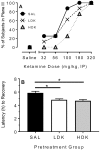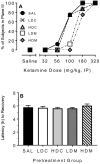Ketamine Tolerance in Sprague-Dawley Rats after Chronic Administration of Ketamine, Morphine, or Cocaine
- PMID: 30696519
- PMCID: PMC6382050
- DOI: 10.30802/AALAS-CM-18-000053
Ketamine Tolerance in Sprague-Dawley Rats after Chronic Administration of Ketamine, Morphine, or Cocaine
Abstract
Ketamine is one of the most commonly used anesthetics in human and veterinary medicine, but its clinical effectiveness is often compromised due to tolerance to its anesthetic effects. Although ketamine tolerance has been demonstrated in a number of behavioral measures, no published work has investigated tolerance to ketamine's anesthetic effects other than duration of anesthesia. In addition, a reported practice in anesthesiology is to alter anesthetic doses for procedures when the patient has a history of drug abuse. Empirically investigating the effects of administration of a drug of abuse on ketamine's potency and efficacy to produce anesthesia could help in the creation of anesthetic plans that maximize safety for both clinicians and patients. The goal of the current study was to test the effects of repeated administration of ketamine, morphine, or cocaine on ketamine's ability to produce anesthesia. In 2 studies, male Sprague-Dawley rats received daily injections of ketamine (32 or 100 mg/kg IP), morphine (3.2 or 5.6 mg/kg IP), or cocaine (3.2 or 10 mg/kg IP) for 14 consecutive days and then were tested on day 15 for ketamine-induced anesthesia by using a cumulative-dosing procedure (32 to 320 mg/kg IP). Chronic treatment with either ketamine or morphine-but not cocaine-produced tolerance to ketamine's anesthetic effects in a dose-dependent manner. These results suggest that ketamine's clinical effectiveness as an anesthetic will vary as a function of its history of use. Furthermore, given that chronic morphine administration produced tolerance to ketamine's anesthetic effects, various pain medications may reduce ketamine's effectiveness for anesthesia.
Figures



References
-
- Ahrnsbrak R, Bose J, Hedden SL, Lipari RN, Park-Lee E. [Internet]. 2017. Key substance use and mental health indicators in the United States: results from the 2016 national survey on drug use and health. [Cited 30 April 2018]. Available at: https://nsduhweb.rti.org/.
-
- Albrecht M, Henke J, Tacke S, Markert M, Guth B. 2014. Influence of repeated anaesthesia on physiological parameters in male Wistar rats: a telemetric study about isoflurane, ketamine–xylazine, and a combination of medetomidine, midazolam, and fentanyl. BMC Vet Res 10:1–15. 10.1186/s12917-014-0310-8. - DOI - PMC - PubMed
-
- Arras M, Autenried P, Rettich A, Spaeni D, Rülicke T. 2001. Optimization of intraperitoneal injection anesthesia in mice: drugs, dosages, adverse effects, and anesthesia depth. Comp Med 51:443–456. - PubMed
Publication types
MeSH terms
Substances
Grants and funding
LinkOut - more resources
Full Text Sources

